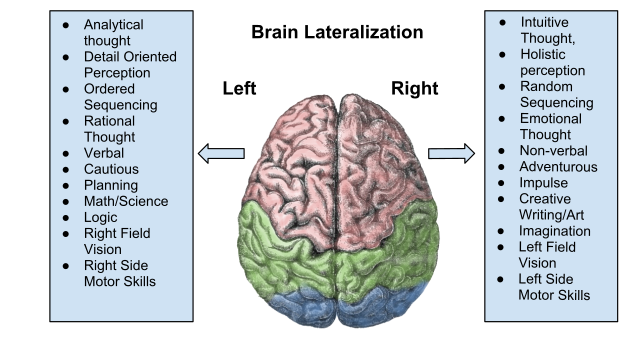In this post, I’d like to explore the brain hemispheres and their relationship to education. Modern neuroscience and Waldorf pedagogical science are finally coming together in some exciting ways. We can use those insights to help us in our teaching and thereby bring more balance to our children.
Are you right brained or left brained?
This question has become as cliché as, “What’s your zodiac sign?” Of course, it’s a question of brain hemispheres and which is dominant in an individual. Typically, we say left-brained people are logical, mathematical, and linear, while right-brained people are creative, dreamy, and definitely non-linear.
There is something to this. Owing to modern advancements, brain scientists have been able to map the function of the right and left brain hemispheres. In the left brain we have functions like logic, math, language, speech, the technical side of music (like learning to read sheet music), linear thinking, and analysis. We also have quickness to anger. ADHD individuals may have an over-dominance of the left brain. Children who are especially intellectually gifted tend to be left brain strong.
In the right brain, we find capacities like imagination, intuition, dreams, relationships, holographic thinking, and synthesis. The right brain is non-linear, but it tends to be more socially aware and has a better feel for the gray areas of life. On the other hand, challenges like dyslexia may suggest an over abundance of the right brain. That being said, children who may be dreamy, but creatively gifted tend to be right brain strong.
EQ and IQ in the Brain Hemispheres
Imagine an old school teacher of algebra. He himself as a math prodigy who taught himself calculus as a young teenager. As your tutor, there’s probably nobody better within 100 miles to help you understand algebra. Yet, every time you make a careless mistake, he scolds you with his words as if slapping you upside the face with them. (This story could potentially be autobiographical.) If you understand that, you have a picture of a highly developed left brain express expressing itself as Intelligence Quotient (IQ). The intelligence is there. The compassion is not. Just because somebody has a highly developed IQ does not mean their emotional intelligence (EQ) is a match.
IQ and EQ are functions of the left and right brain, hemispheres, respectively. We’ve all known children who fall on one or the other end of the spectrum. There are the super brainy kids who yet don’t get on well, socially. On the other hand, there is a wonderfully creative dyslexic girl who is sweet as pie to her peers, gets on well, socially, but can’t read a single page from a book, even at the age of 14.
Today, I would say we are observing more children with high IQs/left-brain activity than the opposite. It’s not that we want them to be more right brain than left brain. We’re striving for a healthy integration of both, a healthy balance. Our modern Western culture tends to overemphasize intellectual intelligence over emotional intelligence.
So, why does it matter?
This matters if we want our children to become free, happy, successful adults. Recall the individual I described above as an algebra tutor, who could possibly be a real person. This individual might even have been one of the most brilliant minds in the world in his field. Yet, his career might have effectively gone nowhere because he couldn’t get on socially.
In this possibly real example (it’s totally real, don’t kid yourself), we have a picture of what happens when one of the brain hemispheres is overly developed while the other cannot keep up. The good news is, there are ways to remediate this imbalance, and they’re not what you may think. It’s not just about giving children more pedantic admonitions about becoming sensitive to their peers’ feelings. It’s about flying under the radar and using methods to stimulate one or the other side of the brain, so it grows.
This is entirely the function of curative education. The work of Robyn Brown is one such example. Delta Genesis is another such organization doing great work in this field. Perhaps in next week’s post, we will get into some more practical specifics.


Leave a Reply
You must be logged in to post a comment.